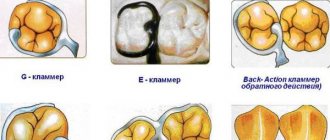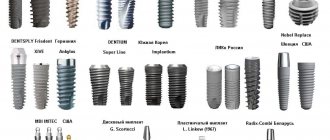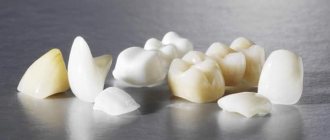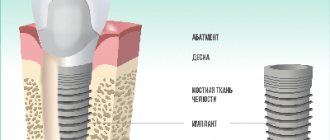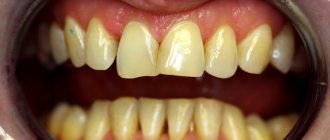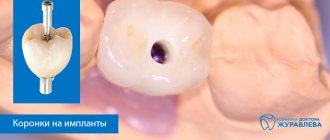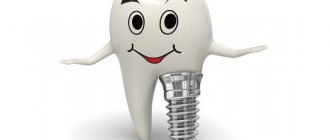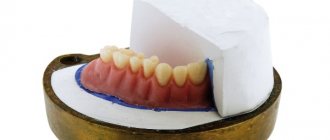Common materials used to make veneers include photopolymer composites, porcelain, and zirconia. One of the most popular compositions is dental ceramics, used both in the creation of solid cast products and in the lining of metal frames. Ceramic veneers installed on the front teeth guarantee the restoration and preservation of smile aesthetics for a long time.
Dental ceramics are used to make feldspar veneers - a category of materials that combines various compositions based on quartz and feldspar. The main difference from porcelain used to create household products is the absence of kaolin, due to its vulnerability to coloring elements. The structure of the composition, as a rule, is a mixture of microcline and albite (feldspar) and quartz, in a ratio of 65/25%, as well as additional elements that ensure the strength of the finished microprostheses. Feldspathic ceramic veneers belong to the most affordable category in terms of cost, but their characteristics in most respects are not inferior to alternative models.
History of appearance
The history of dental ceramics goes back more than 200 years.
The first researchers to study the possibility of using porcelain as teeth and to leave their mark on the documents were the Frenchman Alexis Duchateau and the Italian Nicholas De Chemant. In 1774, they tried to make artificial teeth from traditional green porcelain.
The first dental ceramics that vaguely resembled natural teeth in color was produced by Elias Wildman. This happened in 1838.
Is it correct to call amorphous ceramics glass ceramics?
Due to the presence of the glass phase, this type of ceramic is often called glass ceramic, which is not entirely true. Glass ceramics, or glass ceramic, is a material made by directed crystallization of glass. Sitall is a term that combines “silicate” and “crystal”. The process of formation of crystals into a glass phase is called sitallization. In dentistry, instead of “ceramic glass” they say “glass ceramics”.
Factors Affecting Porcelain
Factors affecting porcelain:
- chemical composition of components;
- the degree of their grinding (dispersity);
- temperature, firing duration.
Indications and contraindications
Installation of veneers on the dentition is recommended if the following factors are present:
- Aesthetic defects of the frontal units, characterized by the presence of irregularities, cracks and chips, as well as abrasions on the enamel surface;
- Detection of hypoplasia – a pathology that negatively affects the development of dental tissue;
- The problem of a “gummy” smile, which requires not only tooth restoration, but also correction of the gum line in the contact area;
- Increased susceptibility to temperature or mechanical irritants;
- The need to eliminate diastemas, as well as mask other problems associated with the shape or appearance of the units.
The most common reason for prosthetics is the patient’s desire to improve the aesthetics of his smile, accompanied by the impossibility of using other enamel whitening techniques. At the same time, it is important to take into account the influence of negative factors considered as limiting contraindications:
- The presence of non-retinated units in the row;
- Diagnosed bruxism;
- Insufficient thickness of the enamel coating;
- Advanced caries requiring additional treatment;
- Damage to more than 60% of the tooth surface;
- Periodontal pathologies;
- Previously installed extensive fillings.
The decision on the possibility of restoration using feldspathic veneers is made based on the results of a comprehensive examination conducted in a clinical setting.
Classification of ceramics
The properties of ceramics are determined by its composition, structure and porosity. Ceramics are classified according to their material composition, crystalline phase composition, structure and purpose. 1. According to the material composition, the varieties of ceramics are faience, semi-porcelain, porcelain, terracotta, cermets, corundum and super-hard ceramics and the so-called stone mass. 2. Based on the composition of the crystalline phase, ceramics made of pure oxides and oxygen-free ceramics are distinguished. 3. Based on their structure, ceramics are divided into dense and porous. Porous ceramics absorb more than 5% of water, and dense ones - 1...4% by mass or 2..8% by volume. Brick, blocks, tiles, drainage pipes, etc. have a porous structure; dense - floor tiles, sewer pipes, sanitary products.
Classification by purpose
Dental ceramics are used for various purposes. Depending on this, it is divided into frame, monolithic and facing. Frame – used for the manufacture of crowns and bridges. Facing – metal (cermet) or ceramic (metal-free ceramics) frames are veneered. Monolithic – designed for making complete dentures.
The requirements for these varieties are different. The framework ceramics must be very durable, the veneering metal-free ceramic crown must have good aesthetic characteristics and reliable adhesion. Monolithic ceramics are generally the strongest of all, so require less invasive preparation and provide longer prosthetic life. Only lithium oxide and disilicate glass ceramics are suitable for its manufacture, while aluminum oxide requires additional lining due to its high abrasiveness.
Classification of ceramics by microstructure
This classification divides ceramics according to the level of content of crystalline components and glass (non-crystalline structure), which can be combined into 4 main categories with several subgroups.
1. Glass ceramics 2. Filled glass ceramics 3. Filled oxide ceramics 4. Oxide ceramics
Glass ceramics consist of silicon oxide, also known as quartz (SiO2), with a small amount of aluminum. In nature, aluminosilicates, which also contain impurities of potassium and sodium, are known as feldspar. In dentistry, artificially synthesized feldspar represented the first ceramic masses for the manufacture of porcelain orthopedic structures. The use of feldspar was first mentioned in 1903 in the works of Charles Land, who described the process of making porcelain crowns in the medical publication Dental Space, but the doctor was faced with the problem of the great fragility of porcelain. Similarly, in 1938, in his Journal of the California Dental Association article, Pincus proposed the concept of a porcelain veneer, but the idea was also unsuccessful, the flexural strength of such porcelain was 20-30 MPa. Later, in connection with the invention of vacuum kilns for firing porcelain, the strength characteristics were improved. The flexural strength varied from 50 to 60 MPa and was achieved as a result of the resulting lower porosity of the material. Ceramics were used for cladding metal frames, as well as in the form of an integral structure
This is interesting: How to eliminate odor from under a tooth crown: what to do
Classification of ceramics by level of transparency
The level of transparency of dental ceramics is indicated in Latin letters:
These four levels are typical only for glass ceramics.
Oxide ceramics only meet the HO level. Zirconium oxide belongs to the MO level and does not correspond to the specified HT. The higher level of transparency of zirconium oxide is explained by a decrease in the porosity of the material. Less porous - scatters light less, acquires transparency and higher strength. The choice of ceramics with a particular transparency depends on the type of denture and the color of the supporting tooth. Highly transparent ceramics are suitable for partial restorations and are not suitable for crowns due to the prospect of translucency of the dark oral cavity. Monolithic dentures are recommended to be made from HT and LT ceramics. To completely or partially cover the shade of the prepared tooth, HO and MO are used.
Main characteristics.
Clays and foundry masses have many characteristics. Some are important for molding products, some are important for obtaining the required properties of the final product, there are also those that are “hidden” in nature and manifest themselves in special cases or after a long time.
FIRING INTERVAL - this characteristic is important if there are restrictions on the firing temperature in production. The minimum temperature is one below which a durable shard will certainly not be obtained. Below the lower temperature, firing can only be carried out for “educational” purposes, for example, in a children's studio. Maximum temperature is the temperature above which noticeable deformation of the product, swelling, etc. begins. phenomena.
SHARD COLOR - the color after firing (the original clay is often a different color). Terracotta is made exclusively from red-burning clays, majolica - from red-, light- and white-burning clays, earthenware and porcelain - only from white-burning clays; for stone products, the color of the shard does not matter.
TEXTURE OF THE SHARD. So-called “clays” usually have a flat, smooth surface, while “fireclays” have a smooth or granular surface. There are masses whose surface, after firing, resembles sandstone, marble, or granite. Some masses allow polishing.
FORMING TECHNIQUES. There are clays that are extremely convenient for modeling, or for shaping on a potter's wheel, or for filling thick-walled products. The differences here are largely arbitrary and determined by experience. Slips (casting masses) are suitable exclusively for casting into plaster molds.
WATER ABSORPTION (shard density) is a numerical characteristic indicating the number of open pores in a fired shard. The lower the water absorption, the denser and stronger the shard. The porcelain shard must have a water absorption exactly less than 1%. The stone mass must be just as dense. Water absorption exceeding 20%, which is acceptable for decorative majolica, is extremely rare.
SHRINKAGE. Reducing the size of a product during drying (air shrinkage) and firing (fire shrinkage). The lower the shrinkage, the lower the likelihood of product deformation. Fireclay masses, as a rule, have a slight shrinkage.
ATTITUDE TO DRYING. Thin masses containing significant amounts of clay make it difficult for water vapor to escape from the thickness of the molded product, and often have large air shrinkage. Such masses are sensitive to drying conditions. Lean masses allow water to pass through more easily, shrink less, and are therefore less sensitive to drying. Fireclay masses are the easiest to dry and can be used to mold products with thick walls.
FROST RESISTANCE. This characteristic applies to the product as a whole. Many masses are frost-resistant in themselves, but the glazes on them may begin to peel off after 2-3 winters.
| The majolica figurine is made of porous red clay and covered with white enamel. She acquired this appearance after wintering outdoors. |
COEFFICIENT OF THERMAL EXPANSION (CTE) characterizes the relative expansion when heated by 1 degree. It is not the CTE itself that is important, but its relationship with the CTE of the glaze. Most glazes will come out without a mark if the CTE of the shard is 60-65 (by 10 to the minus seventh power). The CTE is determined by the composition of the mass and the conditions of its firing.
Composition and properties of the material
The vast majority of ceramic systems consist of an amorphous matrix and a crystalline filler uniformly distributed within it. There are so many types of dental ceramics that it is impossible to examine and understand them without first differentiating them based on some characteristics.
The material can be classified as follows.
By matrix type:
- Feldspathic glass.
- Lanthanum glass (lanthanum in its pure form is a silvery-white, malleable and malleable metal).
- Polymers.
Organic plastics are part of the so-called hybrid ceramics, which have recently appeared in the range of some manufacturers of dental materials. Currently, they are being tested; a final conclusion about the advantages and disadvantages of hybrid ceramics has not yet been made. - No matrix at all. This type includes a material consisting almost 100% of aluminum oxide crystals sintered together.
By filler:
- quartz;
- leucite;
- alumina-magnesia spinel;
- and other fillers, which are discussed below.
According to manufacturing technology, ceramics can be:
- sintered;
- cast;
- pressed.
- infiltrated.
The basis of porcelain for use in dentistry is ceramics, consisting of elements such as quartz (silicon oxide - SiO2) and feldspar (a mixture of sodium aluminosilicate (Na2O Al2O3 6SiO2) and potassium silicoaluminate (K2O Al2O3 6SiO2)).
Such ceramics are called “feldspathic”. Unlike porcelain used in everyday life, it does not contain kaolin, which, due to its opacity, does not allow obtaining a shade identical to the color of natural teeth.
The role of feldspathic material
The disadvantage of feldspathic ceramics is their high fragility. The tendency to form cracks does not allow obtaining a bending strength of more than 40-60 MPa.
For a long time, the goal of dental researchers has been to increase the strength of feldspathic ceramics by changing its structure, adding strengthening fillers and improving firing technology.
The first positive results were obtained by reducing the size of quartz particles and evenly distributing them over a glass matrix.
Together with the use of vacuum furnaces, which reduced the porosity of the ceramic mass, this made it possible to obtain feldspathic material with a bending strength of up to 150 MPa. But this still was not enough.
This is interesting: Why do you need temporary crowns on an implant: pros and cons, types
If the frontal teeth, made of porcelain with a strength of 150 MPa, coped with their functions for a relatively long time, then the dentures installed on the lateral teeth or those that were of greater length could not withstand the chewing load.
Real success was achieved by placing other compounds, mainly oxides, into the glass matrix as fillers. Distributed evenly over the feldspathic glass, the filler crystals prevented the propagation of cracks in it, making the material much stronger.
As a result, a large number of durable and technologically advanced materials have been developed, united under the general name “dental ceramics”.
The following compounds are used as fillers.
- Fluorapatite (Ca10(PO4)6(F)2). The addition of fluorides made it possible to achieve a strength of 120-150 MPa.
- Leucite (KalSiO6). Ceramics with a small content of leucite have a flexural strength of about 150 MPa. Increasing the potassium oxide content to 50% made it possible to obtain a material with a strength of 200 MPa.
- Magnesium and aluminum oxides (MgAl2O4, alumina-magnesia spinel). Feldspathic ceramics reinforced with spinel have a strength of up to 350 MPa. Its peculiarity is that, unlike other types of hardened ceramics, it has very good aesthetics.
- Lithium apatite disilicate (Li2Si2O5, SiO2-Li2O-SiO2). The filler allows you to increase the strength of the material up to 450 MPa.
- Aluminum oxides (Al2O3) increased the strength to 450 MPa.
- Zirconium oxide (ZrO2). Its addition made it possible to increase the flexural strength of ceramics to 650-700 MPa.
In addition to strengthening fillers, the ceramics contain dyes:
- iron oxide (brown);
- copper (green);
- cobalt (blue);
- titanium (brown-yellow).
Organic additives (starch + sugar) make the ceramic mass plastic, making it easier to work with.
It should be noted that increasing the strength of the material sometimes conflicts with aesthetic parameters. Feldspathic ceramics have the greatest aesthetics.
The addition of most fillers impairs transparency, thereby reducing the aesthetics of the artificial tooth. Therefore, many types of reinforced material are used as a frame for prostheses.
By covering it with transparent feldspathic ceramics, a color effect is obtained that is extremely similar to the enamel of natural teeth.
Hybrid ceramic options
Other, “intermediate” versions of ceramics are also used in dentistry. For example, glass infiltrated ceramics are a sintered porous oxide variety impregnated with special glass after milling the frame. In this technology, scientists tried to combine the strength of oxide ceramics and the transparency of glass ceramics, but they failed to achieve good results. Therefore, only frame parts are made from this material.
Recently, new hybrid materials have appeared - composite blocks containing an organic matrix, for example Lava Ultimate (3M Espe) or Enamic (Vita). They cannot be fired in a kiln and have nothing in common with ceramics.
Receiving technology
Powder obtained from ceramic mass using a special technology is used as blanks for creating prostheses .
The mixture is fritted (primary firing). The resulting product is called “frit” and is a fine-crystalline dispersion of quartz with fillers.
Due to the rapid cooling, the frit has many cracks that allow it to be ground into a fine powder. Fritting also promotes uniform distribution of components throughout the material.
Ceramic mass, which serves as the starting material for the manufacture of prostheses in laboratory and factory conditions, exists in the following forms.
- Powder made from frit. It is used by dental technicians in laboratory conditions (mixed with water), as well as in factories for the production of dentures. This form of the original ceramics is called conditioned.
- Tablets compressed from powder. They are used in particular for the manufacture of crowns using the injection molding method.
- Solid machine blocks. The term “machine” means that these blocks are designed for cutting crowns and inlays using special milling equipment using CAD/CAM technology.
- Infiltrated ceramics. It consists of a powder filler and an amorphous lanthanum glass matrix.
This is interesting: Correction with aligners
The video shows the process of casting and pressing ceramics.
What types of clays are there?
Nature surprises us with its diversity. They exist in different quantities: gray, white, red, yellow, green, blue, dark blue, black clay. The variety of colors is explained by the fact that in different clay deposits, certain minerals are present, which give the rocks different colors.
For example, the color of red clay is explained by the presence of an admixture of hematite (a compound of iron and copper); white clay contains kaolinite; blue – cobalt and cadmium salts; yellow – sodium compounds; black color, iron substances and carbon compounds are present.
The demand for all types of clay (construction, ceramic, fired, powder, abrasive, refractory, natural red, fireclay) is explained by physical and chemical properties:
- good ductility, porosity, swelling, shrinkage (air and fire), fire resistance, dispersibility;
- property of water resistance, stable water insulator is actively used in construction and landscape design.
Varieties
Ceramics can be present in the prosthesis in the form of metal ceramics (the material is applied to a metal base) and all-ceramic structures.
Metal ceramics have been successfully used by dentists for a long time. All-ceramic prostheses have proven their viability only since the 80-90s of the last century.
All-ceramic designs
Depending on the design, all-ceramic prostheses come in two types - frameless and with a frame made of zirconium or aluminum oxides.
The first type is used for the manufacture of veneers, inlays, crowns, and small bridges. Products with a frame include extended bridge structures and crowns.
The production of all-ceramic dentures can be carried out using two methods:
- Manual production technology. After preparing the patient’s teeth, the dentist takes an impression of them, on the basis of which a plaster model will be made.
In a dental laboratory, a ceramic frame is formed on a refractory model, and then fired at a certain temperature.The finished frame is lined with ceramic mass, recreating the anatomical shape and shade of the tooth being restored.
- Computer technology. Based on a computer model of the patient’s jaw, a prosthesis is formed. Next, the product is turned on a special machine.
Among the advantages of all-ceramic dentures, they note their high biological compatibility with the tissues of the human oral cavity, as well as aesthetics , due to which the products are used to restore anterior teeth.
Sintered glass crystals
Sintered glass crystals are produced in two ways:
- by sintering glass powders with the addition of a crystal former;
- by sintering glass powder with the introduction of a crystal former at the cooking stage.
By adding tiny particles of insoluble oxides to glass crystals, an opalescent effect is achieved. This allows you to achieve maximum similarity of the prosthesis with tooth enamel.
The advantages of glass-crystalline structures also include their high mechanical strength, wear resistance, and moisture resistance. Products made from sintered glass crystals are used to make veneers, inlays, and crowns.
Cast ceramics
The ceramic casting technique was introduced in 1980. Its essence was that material is cast into special refractor molds using a centrifuge.
The advantages of the manufactured glass-ceramic structure were considered to be its low porosity and high degree of polishability.
This technology is quite difficult to implement. In addition, it requires large economic costs. Another disadvantage is the impossibility of casting one-piece bridge-type prostheses. As a result, this method of making dentures is not currently used.
Pressed ceramics
The manufacturing technology of pressed ceramic prostheses consists of performing the following steps:
- placing the wax blank in a special retractor-phosphate mold;
- wax melting;
- filling a void with glass-crystalline material under high temperature and high pressure under vacuum conditions.
The advantages of products made from pressed ceramics include their high strength, accurate color rendering, low weight, and minimally invasive fixation process.
The key disadvantage of pressed ceramics is the impossibility of using it for the manufacture of bridges.
Tooth preparation
Treatment of the base prior to installation of the structure includes a number of sequential procedures:
- Initial examination, during which the condition of the dentition and root area is assessed, and a treatment plan is formed;
- Professional cleaning and selection of shade of the workpiece;
- Preparation of the unit on which installation is planned.
The development of technology makes it possible to carry out the process of grinding teeth using non-contact methods - for this, laser, ultrasound or air-abrasive treatment are used (not always used, if possible).
Manufacturing stages
To create veneers, a technique is used to bake several layers of ceramic material. The mixture is applied to a stamp or foil, in which a model is wrapped, replicating the anatomical structure of the tooth. Condensation of the product is carried out using grooved tools to remove excess moisture. After applying the enamel coating, re-firing is performed.
The finished onlay fully matches the shade of a natural tooth and is resistant to dyes and mechanical stress. Veneers are fixed using an adhesive that penetrates into the structure of the base.
Service life and cost
The service life of ceramic linings is at least ten years, and largely depends on operating conditions. Compliance with basic hygiene procedures allows you to extend the life of veneers and preserve their aesthetic properties. The cost of the service is determined by the complexity of the technology, and varies from 25 thousand rubles per unit.
Reviews
The use of dental ceramics allows dental laboratory specialists to create dentures whose appearance is as close as possible to the natural elements of the jaw row.
Thanks to the improved composition, these products are only slightly inferior in strength to metal structures.
Sources:
- https://www.vash-dentist.ru/protezirovanie/nesemnyie-p/naznachenie-stomatologicheskoy-keramiki.html
- https://stomatology.su/stomatologicheskaya-keramika.html
- https://ppt-online.org/554131
- https://ppt-online.org/380042
- https://stomatology.su/klassifikaciya-stomatologicheskoy-keramiki.html
- https://stomweb.ru/articles/keramicheskie-materialy-v
- https://zubovv.ru/protezirovanie/nesemnyie-p/stomatologicheskaya-keramika.html
Application of fireclay clay
To finish the external surface of buildings, fireclay made from white clay is used. To acquire the quality of heat resistance, the clay is thermally treated. After heating, kaolin becomes stone, it is crushed to produce fireclay clay, which is used for the manufacture of any heat-resistant construction and the production of refractory bricks and various decorative products. Note that there are several compositions for the production of fireclay mass; the components are taken in different percentages of water and mass; in one version, coarsely ground powder is used, in the other, finely ground. The addition of calcined powder differs in different mixtures. All compositions are selected in accordance with the requirements of the characteristics of the declared technological maps.
